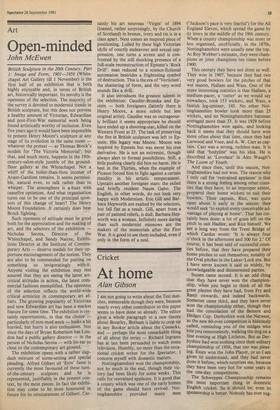Art
Open-minded
John McEwen
British Sculpture in the 20th Century. Part I: Image and Form, 1901-1950 (Whitechapel Art Gallery till 1 November) is the first half of an exhibition that is both highly enjoyable and, in terms of British art, historically important. Its novelty is the openness of the selection. The majority of the survey is devoted to modernist trends in British sculpture, but this does not prevent a healthy amount of Victorian, Edwardian and post-First-War memorial work being found artistically worthy of inclusion. Even five years ago it would have been impossible to present Henry Moore's sculpture at any stage of its evolution in the same room — whatever the pretext — as Thomas Brock's models for 'The Victoria Memorial': but that, and much more, happens in the 19thcentury-salon-style jumble of the groundfloor gallery at the Whitechapel. Not a whiff of the holier-than-thou incense of Avant-Gardism remains. It seems permissible, natural even, to talk rather than to whisper. The atmosphere is a-buzz with ceasefire optimism. And what organisation turns out to be one of the principal sponsors of this change of heart? The Henry Moore Foundation. It certainly does beat Brock fighting.
Such openness of attitude must be good both for the appreciation and the making of art, and the selectors of the exhibition — Nicholas Serota, Director of the Whitechapel, and Sandy Nairne, Exhibitions Director at the Institute of Contemporary Arts — deserve medals for their opportune encouragement of the notion. They are also to be commended for putting on something so invigoratingly with-it. Anyone visiting the exhibition may rest assured that they are seeing the latest artcritical attitudes in action, the latest commercial fashions exemplified. The openness of the selection reflects the world-wide critical armistice in contemporary art affairs. The growing popularity of Victorian and now Edwardian art has been a market feature for some time. The exhibition is certainly opportunistic, in that the choice — particularly of non-mod work — looks a bit hurried, but hurry is also enthusiasm. Not since the days of Bryan Robertson has London had a public gallery director — in the person of Nicholas Serota — with his ear so close to the contemporary art ground.
The exhibition opens with a rather slapdash mixture of scene-setting and special pleading. Alfred Gilbert of 'Eros' fame is currently the most favoured of these turnof-the-century sculptors and he is represented, justifiably in the present context, by the most pieces. In fact the exhibition may come to be most honoured in future for its reinstatement of Gilbert. Cer tainly his art nouveau 'Virgin' of 1894 (loaned, rather surprisingly, by the Church of Scotland) in bronze, ivory and tin is in a class apart. Next comes an inspired piece of positioning. Lulled by these high Victorian idylls of courtly endeavour and sexual suppression, one turns a screen and is confronted by the still shocking presence of a full-scale reconstruction of Epstein's 'Rock Drill': man reduced to a science-fictional automaton bestrides a frightening symbol of destruction. This is the era of `Vorticism', the shattering of form, and the very word sounds like a drill.
It also introduces the greatest talents in the exhibition: Gaudier-Brzeska and Epstein — both foreigners (latterly there is Henry Moore, a more subtle but less original artist). Gaudier was so outrageously brilliant it seems appropriate he should have ended up a shooting-star, killed on the Western Front at 23. The task of preserving the fire in British sculpture was left to Epstein. His legacy was Moore. Moore was inspired by Epstein but was never his true derivative. He is not an extremist, though always alert to formal possibilities. Still, a little pushing clearly did him no harm. He is best in the Thirties, when the example of Picasso forced him to fight against a certain timidity in his artistic temperament. Upstairs another foreigner stars: the exiled and briefly resident Naum Gabo. The English, in other words, do not look very happy with Modernism. Eric Gill and Barbara Hepworth are exalted by the selectors, but fall flat as a result. Gill, apart from a pair of painted reliefs, is dull; Barbara Hepworth was a woman. Infinitely more daring than such modernist minnows are the makers of the memorials after the First War. It is good to see them included, even if only in the form of a nod.


































 Previous page
Previous page